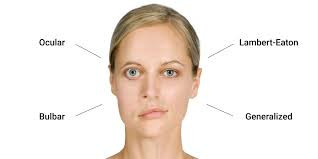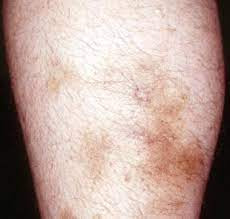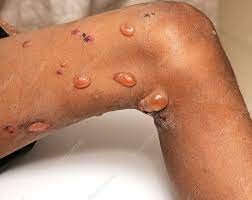Definition
Myasthenia gravis (MG) is an autoimmune disorder affecting nerves and muscles. This disease is characterized by the weakening of body muscles due to disruptions in the connection between nerves and muscles. It is a rare condition that significantly impacts the quality of life of those affected.
Causes
The most common cause of myasthenia gravis (MG) is an immune system disorder. However, in some cases, it can be caused by genetic abnormalities at the neuromuscular junction (NMJ).
Nerve signals originating from the brain regulate the skeletal muscles in the body. These signals travel through nerves to the location where nerves and muscles meet. However, muscle fibres do not come into direct contact with nerves. Instead, there is a space between the nerve endings and muscle fibers called the NMJ.
When nerve signals from the brain reach the nerve endings, they trigger the release of a chemical called acetylcholine. Acetylcholine crosses the NMJ space to reach the muscle, where numerous receptors for it exist. Muscle contraction occurs when enough acetylcholine binds to these receptors.
In individuals with myasthenia gravis (MG), the number of acetylcholine receptors at the neuromuscular junction (NMJ) significantly decreases, often by as much as 80%. This reduction is primarily caused by antibodies that damage or block the receptors.
Antibodies are proteins that play a critical role in the immune system's defense against foreign proteins, known as antigens, that can harm the body, such as bacteria and viruses.
In MG, the immune system produces antibodies that attack the acetylcholine receptors at the NMJ. These antibodies accelerate the damage to the receptors faster than the body's ability to replace them. As a result, muscle weakness occurs when acetylcholine cannot bind to enough receptors at the NMJ.
Risk factor
Previous research has indicated that women are more likely to develop myasthenia gravis (MG) compared to men. Typically, the peak age for the occurrence of MG in women is in the second and third decades of life, while in men, it is in the seventh and eighth decades.
However, with the aging population, MG is becoming more common in men, with symptoms typically onset after age 50.
Symptoms
Individuals with myasthenia gravis (MG) typically experience specific muscle weakness symptoms rather than general body weakness. Ocular muscle involvement, characterized by drooping eyelids or double vision, is an initial symptom in two-thirds of patients. Nearly all patients will experience these conditions within 2 years of symptom onset.
Muscle weakness in the mouth and throat, characterized by difficulty chewing hard, chewy, or solid foods, difficulty swallowing, or speaking, is an initial symptom in about one-sixth of patients with myasthenia gravis.
Limb weakness is experienced in only 10% of patients.
The severity of muscle weakness tends to fluctuate throughout the day. Symptoms are usually milder in the morning and worsen as the day progresses, particularly after excessive use of the affected muscles.
The course of myasthenia gravis varies but typically worsens over time. In 10-40% of cases, weakness is only limited to the eye muscles. The remainder will experience progressive weakness within the first 2 years, involving the mouth, throat, and limbs muscles. Severe weakness can occur within the first year in two-thirds of patients.
Symptoms may fluctuate over short periods and then worsen over several years, known as the active stage. This is followed by an inactive stage, during which fluctuations in muscle weakness may still occur, often associated with body fatigue or other illnesses. After 15 to 20 years, weakness often becomes persistent, and the affected muscles may shrink due to muscle mass reduction.
Factors that can exacerbate symptoms of myasthenia gravis include emotional stress, respiratory virus infections, thyroid disorders (hypothyroidism or hyperthyroidism), pregnancy, menstrual cycles, medications affecting nerves, and increased body temperature.
Diagnosis
MG is often not diagnosed in very mild cases for several months and even years. Muscle weakness with unusual distribution and fluctuating symptoms often make symptoms look like a mental illness.
People with lower temples, multiple vision, and difficulty speaking or swallowing can also experience an abnormality in the brain and often undergo examinations for stroke, brain tumors, or multiple sclerosis.
Examinations that can be done to enforce MG diagnosis include:
- The chloride edrophonium test (Tensilon promise). The weakness due to the abnormality of transmitting a neural signal on NMJ will improve after the injection of chloride edrophonium, often referred to as the Tensilon total test. Some people who do not respond to chloride edrophonium injections can give a response to neostigmin injections due to longer work durations. Neustigmine injection is mainly useful in infants and children whose response to chloride edrophonon may be too short to be assessed. In some people, a daily pyrodigmin administration experiment can be conducted that can provide an improvement to symptoms that may not be seen with only a single injection of chloride or neostigmine edrophonium.
- Examination of antibodies in the blood. Several types of antibodies were found in most MG sufferers. However, some MG sufferers do not have detected antibodies. In this case, the diagnosis is based on symptoms, responses to chloride edrophonium tests, and electrical examination results.
- Electromiography (EMG). This examination is carried out by providing recurrent neural stimulation with small electric waves to exhaust muscles. Muscles in MG cannot overcome this recurrent stimulation, unlike normal muscles.
Management
Therapy for myasthenia gravis (MG) is individualized based on various factors including the severity of the disease, the patient's age, gender, and level of functional impairment.
Assessing response to therapy can be challenging due to the fluctuating nature of symptom severity in MG. Spontaneous improvement, and even remission, can occur without specific therapy, particularly in the early stages of the disease.
Treatment options for MG include:
- Cholinesterase inhibitors: These drugs inhibit the breakdown of acetylcholine, increasing its concentration at the neuromuscular junction (NMJ).
- Thymectomy: Surgery to remove the thymus, an immune tissue that produces antibodies, can benefit MG patients.
- Prednisone therapy: Prednisone often leads to significant improvement or remission in over 75% of individuals with MG.
- Immune system suppressants: Azathioprine can improve symptoms in most patients, with effects typically seen after 4 to 8 months. Patients not responding to corticosteroids may respond to azathioprine, and vice versa. Cyclosporine is also sometimes beneficial for MG therapy. Cyclophosphamide can be administered via injection or orally for MG therapy.
- Plasma exchange: This therapy is used short-term for patients experiencing sudden worsening of MG symptoms or for those who do not respond to other treatments.
Complications
MG complications can be managed, but some can be life-threatening. Some MG complications include:
- Myasthenic crisis: This is a life-threatening condition in which the respiratory muscles become too weak, leading to respiratory failure.
- Thymus gland tumors: Some individuals with MG may have tumors in the thymus gland. These tumors are typically benign, but they can still pose complications and require medical attention.
Prevention
While there is no known way to prevent myasthenia gravis (MG), individuals with MG can take several steps to prevent relapses:
- Practice good hygiene and avoid close contact with sick individuals to prevent infections.
- Promptly address any infections that do occur.
- Avoid extremes of temperature, both hot and cold, as they can exacerbate MG symptoms.
- Avoid excessive physical exertion or exercise, which can strain weakened muscles.
- Learn and utilize effective methods for managing stress, as stress can worsen MG symptoms.
When to see a doctor?
It's important to consult a doctor if you experience difficulty:
- Breathing
- Seeing
- Swallowing
- Chewing
- Walking
- Using your arms or hands
- Holding up your head
Looking for more information about other diseases? Click here!
- dr Ayu Munawaroh, MKK
MG Education | MGFA. (2022). Retrieved 22 September 2022, from https://myasthenia.org/MG-Education
Myasthenia Gravis Clinical Overview | MGFA. (2022). Retrieved 22 September 2022, from https://myasthenia.org/Professionals/Clinical-Overview-of-MG
Myasthenia gravis - Symptoms and causes. (2022). Retrieved 22 September 2022, from https://www.mayoclinic.org/diseases-conditions/myasthenia-gravis/symptoms-causes/syc-20352036
Diagnosis & Treatment of Myasthenia Gravis. (2022). Retrieved 23 September 2022, from https://www.webmd.com/brain/understanding-myasthenia-gravis-treatment












